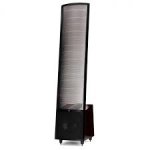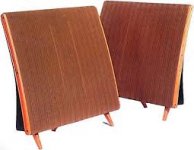But instead of compromise, why not just advance the design? It seems we've settled for good enough. The attributes of ESLs suggest equal transient performance in the bottom end is necessary to complete the over all spectrum, no?I think that because the dynamics is perceived mainly in the medium / low range. And the solution is to add the conventional dynamic speaker to replace that flaw, as you can see in the photos.
But instead of compromise, why not just advance the design? It seems we've settled for good enough. The attributes of ESLs suggest equal transient performance in the bottom end is necessary to complete the over all spectrum, no?
"Transient performance" does not apply to the dynamic range. (These would be the "very short details, to put it awkwardly). The theme is simply dynamic and I think there are technical details that prevent it from being achieved in the low zone as in the rest of the spectrum.
I am not a specialist, I have simply listened. But I know Apogee holders who came here to "specialists" in ESL, who add 2 x 8 inches in a Martin Logan-style terraced box. I regret not being able to give more information about it because it is a local forum here, and I don't know if you are interested, but if you want I could look for the link.
Anyway, some connoisseur of the topic of this forum will surely give us his wise information, we will have to wait .....
I get the technicalities. I'm wondering why the limitations have not been overcome. Imagine a seriously dynamic flat panel driver
They have been overcome, however they get so huge noone has the space, or money, to use them. Google metaxas electrostars emperor...
I have both Model 3 and Monitor 3 Acoustats and there is a remarkable difference in dynamic performance between them. I mistakenly interpreted transient performance in my comparative description in my previous post. As I mentioned, I understand the limitations and solution in current designs. I'm wondering if there is a technical aspect not yet explored because of practical/cost/price point issues. For example, in my infantile mind's eye I see an accordian perimeter on a panel sufficiently stiff so as to prevent the diaphragm from slapping the stators yet compliant enough to allow a lot more Xmax, possibly with a stiff rather than soft diaphragm? Higher current/voltage?They have been overcome, however they get so huge noone has the space, or money, to use them. Google metaxas electrostars emperor...
They can be very dynamic, my first pair of unsegmented ESL's could de-bone chickens with the dynamics in the sweet spot. But they had a pair of TL woofers running from 100hz down.
I do not doubt his words, but keep in mind that conventional speakers achieve the same from much broader points, which is very small in some ESLs (e.g. Quad ESL57).
I simply don't understand the OP's premise:
ESLs - any kind - will never re-arrange your furniture, no - a dipole simply cannot pressurise the space: and that said - the portrayal of the scale and detail and internal dynamcs of anything on the recording, at seriously-low %thd at home listening levels, is as-yet mostly unmatched via any tech.
What is meant by 'no dynamics"? - really. I'd like to understand the complaint better.
ESLs - any kind - will never re-arrange your furniture, no - a dipole simply cannot pressurise the space: and that said - the portrayal of the scale and detail and internal dynamcs of anything on the recording, at seriously-low %thd at home listening levels, is as-yet mostly unmatched via any tech.
What is meant by 'no dynamics"? - really. I'd like to understand the complaint better.
What is meant by 'no dynamics"? - really. I'd like to understand the complaint better.
Perhaps the difference in sound pressure (SPL) between the weakest passages of the musical work and the strongest ?

Right, it's that area up to about 500 hertz in question hereI do not doubt his words, but keep in mind that conventional speakers achieve the same from much broader points, which is very small in some ESLs (e.g. Quad ESL57).
You seem to understand perfectlyI simply don't understand the OP's premise:
ESLs - any kind - will never re-arrange your furniture, no - a dipole simply cannot pressurise the space: and that said - the portrayal of the scale and detail and internal dynamcs of anything on the recording, at seriously-low %thd at home listening levels, is as-yet mostly unmatched via any tech.
What is meant by 'no dynamics"? - really. I'd like to understand the complaint better.
Exactly...we're gettin thereI think they do not sound that dynamic below 500Hz because the electrostatic design limits excursion.
Lets get some serious excursion happening with these speakers. It can't not be possible
But it can.
Exactly...we're gettin there. So I don't want to know why, that's already well known. What I want to know is why there has not been ongoing r+d into this design. Lets get some serious excursion happening with these speakers. It can't not be possible

I don't think R&D is required. It's all very clear to the community. To get more excursion, you need more diaphragm spacing, which means you need (a lot!) more high voltage biasing and high voltage signal to get that excursion happen. You want to half the lower limit, you need to double the spacing etc etc.
There's no theoretical limit, it is all practical. Think Beveridge squared, with a power supply and amplifier system rivaling the CERN installation.
If you are willing to spend the effort and money there's no reason why you couldn't get any dynamic range you want.
Jan
I ask the question back.. why is people ugly?
A dynamic speaker has approx 10 times the distortion as ESL.
More distortion at higher SPL... right?
Comparing a transient in a dynamic speaker to an ESL, do an FFT analys of both.
I think it is so simple.
The listening result is that you hear the sum of the transient AND the distortion (of higher orders) in a typica dynamic speaker, and you like that..
I guess you could mimic massive transient performance with ESL speaker and a DSP.
Or just continue to listening to dynamic speakers!
I have both ESL63s and Beveridge 2sw2, and the Beveridge has more dynamic sound. But they distort more than the Quads... Beveridge is a perfect Party speaker. Sounds good anywhere in the room! Standing sitting or walking around. Increadible piece of engineering! But in the sweet spot, QUAD is the winner. (Both speakers has active filtering)
A dynamic speaker has approx 10 times the distortion as ESL.
More distortion at higher SPL... right?
Comparing a transient in a dynamic speaker to an ESL, do an FFT analys of both.
I think it is so simple.
The listening result is that you hear the sum of the transient AND the distortion (of higher orders) in a typica dynamic speaker, and you like that..
I guess you could mimic massive transient performance with ESL speaker and a DSP.
Or just continue to listening to dynamic speakers!
I have both ESL63s and Beveridge 2sw2, and the Beveridge has more dynamic sound. But they distort more than the Quads... Beveridge is a perfect Party speaker. Sounds good anywhere in the room! Standing sitting or walking around. Increadible piece of engineering! But in the sweet spot, QUAD is the winner. (Both speakers has active filtering)
- Status
- This old topic is closed. If you want to reopen this topic, contact a moderator using the "Report Post" button.
- Home
- Loudspeakers
- Planars & Exotics
- Why aren't ESLs dynamic?

